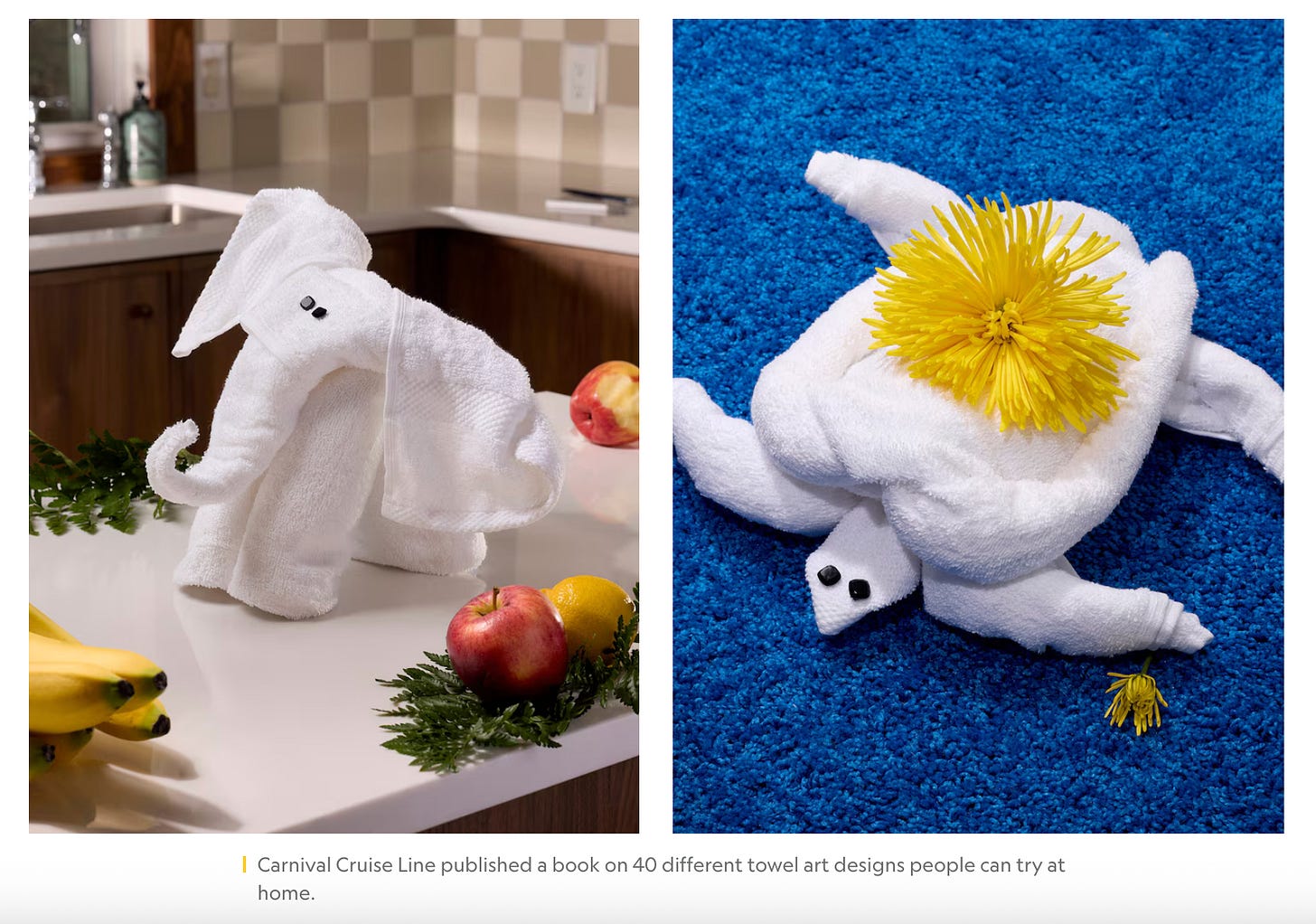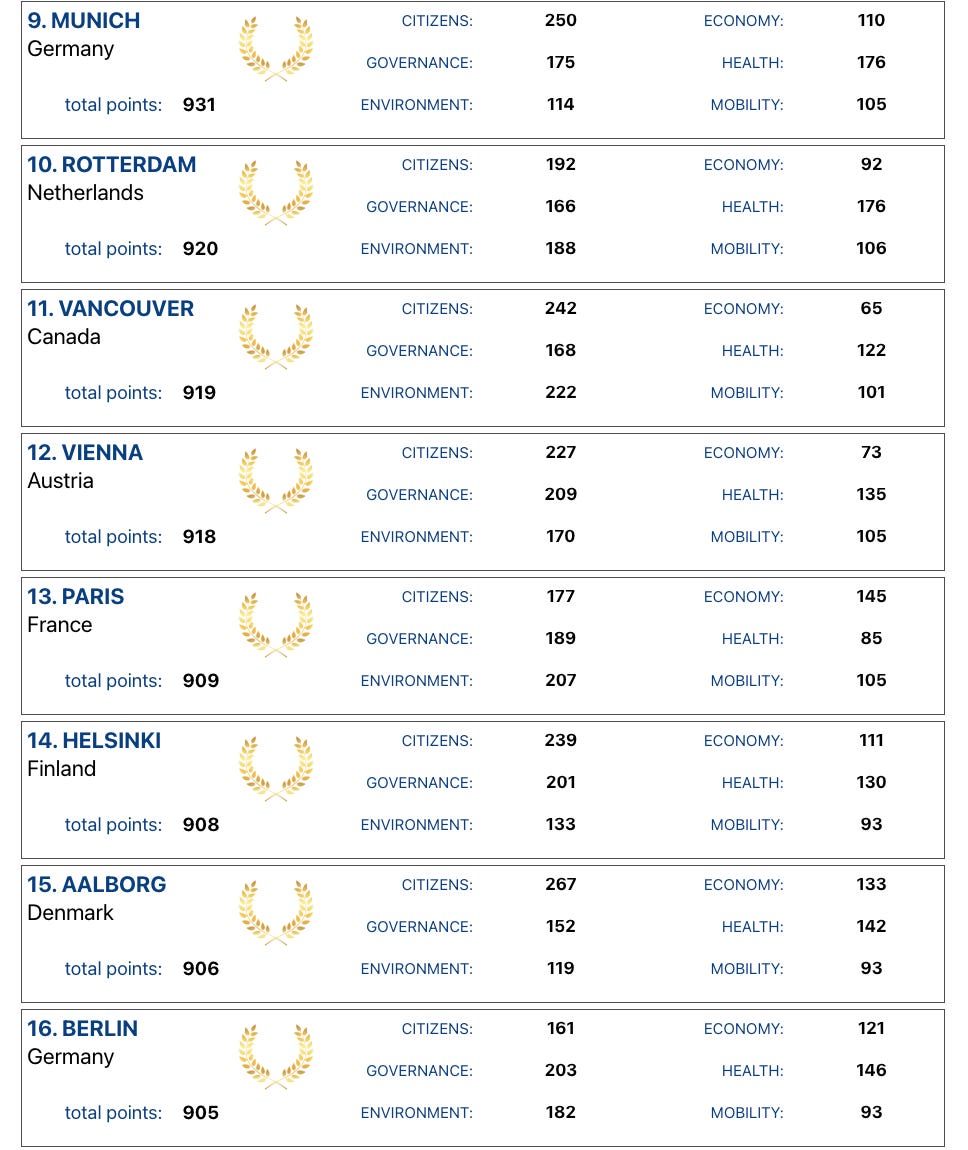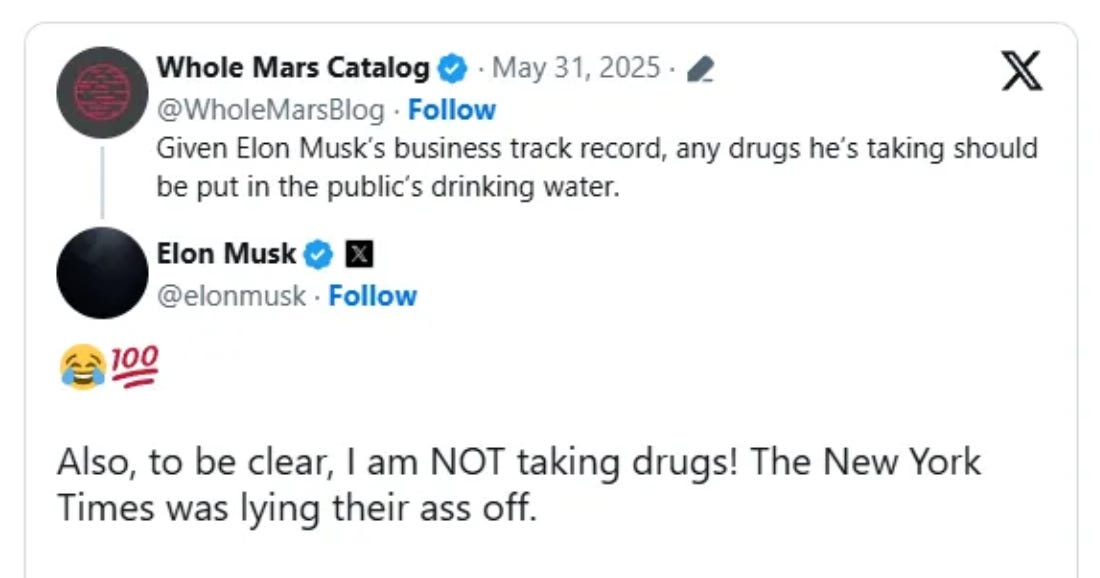Towel Art
You know when you go to a fine-ish Mexican resort, or on a cruise ship, the maids make little designs with the towels? A bed garnish. Usually a swan or such. Some have taken towel art to a new level:
***
The Happiest City in the World. Then 15 more in order, by
New York, New York is number 17.
***
He’s such a riot:
***
So many Chinese women get plastic surgery in South Korea that China now warns them to get a doctor’s note since their appearance no longer matches their passport picture.
***
Where did I leave that highway?
“Lost highways" in America refer to roads that have been abandoned, bypassed, or decommissioned due to changes in traffic patterns, construction of newer routes, or natural events such as landslides. These highways often become relics of earlier eras, sometimes reclaimed by nature or repurposed for hiking and biking, and can be found scattered across the country. For example:
Abandoned Pennsylvania Turnpike (Pennsylvania)
A 13-mile stretch east of Breezewood, PA, featuring three tunnels, was bypassed in 1968 after new tunnels were built to handle increased traffic. It's now a popular spot for hikers and explorers
Highway 80 (Across the South and Southwest)
Once a major transcontinental route from Savannah, Georgia, to San Diego, California. The rise of the Interstate Highway System in the 1950s led to its decline, and many stretches are now desolate or preserved as historic routes1.
Highway 39 (California)
Closed in 1978 after a massive rock slide near Los Angeles. The four-and-a-half-mile closed section is only accessible to emergency vehicles but is popular among hikers and bikers for its scenic views
Highway 95 and the McPhaul Suspension Bridge (Arizona)
The old bridge, built in 1929, was left behind after the highway was rerouted in 1968. The bridge stands unused in the desert, a relic of earlier infrastructure1.
Pennsylvania Route 23 "Goat Path Expressway" (Pennsylvania)
An unfinished bypass project abandoned in 1977. The graded area was covered with dirt and is now used by local farmers, with remnants still visible1.
I-80 Interchange in Farmington, Connecticut
Built in the 1960s for a planned beltway that was never finished. Some ramps and bridges remain unused, covered in graffiti
***
Low expectations: the state drink of Indiana is water.
***
The top 100 highest-scoring fighter aces in history, including those from World War II, are overwhelmingly German according to a Reddit thread discussing the topic, with Erich Hartmann holding the record with 352 confirmed kills. This is due to several factors, including the number of aerial victories claimed by German pilots.
***
Pharrell Williams and his partner Chad Hugo (AKA: The Neptunes) were responsible for producing 43% of the songs played on US radio in 2003. This was widely reported, but not independently verified.
In 2013, Pharrell Williams achieved a comparable level of influence with multiple chart-topping hits, though no equivalent percentage-based statistic is cited for that period. The songs included "Get Lucky" with Daft Punk, "Blurred Lines" with Robin Thicke, and his own solo single "Happy.”
***
Psychology Today suggests that the payment method used can influence how we perceive a transaction. Paying with cash is perceived as more painful because the loss of money feels more immediate. In contrast, using a credit or debit card decouples the purchase from the financial loss.
***
The Abernathy Boys Rode Alone—At Age 6 and 10
In 1910, two young brothers—Bud (10) and Temple (6) Abernathy—rode horseback from Oklahoma to New York City. Alone. No parents. No backup.
That’s over 2,000 miles through rough weather and wild terrain.
Who Were These Kids?
Their dad, Jack Abernathy, was a U.S. Marshal and buddy of Teddy Roosevelt. He raised his sons to be tough. Taught them to ride, survive, and think for themselves.
This trip wasn’t a stunt. It was a statement. These boys wanted to meet Roosevelt in person when he got back from Africa. And they did.
How Did They Pull It Off?
They planned their route around rail lines and towns.
Some stops were pre-arranged, but most were improvised.
They sent telegrams and letters to check in with their dad.
Newspapers followed their story, so locals often helped.
The boys had serious riding skills—and guts.
They rode through storms, crossed rivers, and handled every challenge together. When they finally reached Manhattan, they were greeted with a hero’s welcome and a ticker-tape parade.
What Happened After?
They didn’t stop. The boys went on more epic rides, including New York to San Francisco. Statues now stand in Frederick, Oklahoma to honor their fearless spirit.
Bottom line:
Two kids. Two horses. One wild ride.
Proof that courage doesn’t wait for adulthood.
***
Early American humans, particularly in South America, hunted and used the shells of giant armadillos (glyptodonts) for shelter and other purposes. These armadillos were car-sized and provided a valuable resource, with their shells even serving as temporary shelters from the elements.
***
While the term "Gypsy" is now widely recognized as a shortening of "Egyptian," it's important to remember that Romani people are not from Egypt. This misconception arose in the Middle Ages when Romani people, or some similar groups, were mistakenly believed to be from Egypt, leading to the use of the term "Gypsy". They are believed to have originated in the Punjab region of northern India.
***
Stephanie Case won an ultramarathon race in Wales, running more than 60 miles over rough terrain — and stopping three times to breastfeed her 6-month-old baby along the way.
***
A couple of great apps I have fun with:
Bebot, robot synth (“Whole Lotta Love” vibes)
***
Franklin W. Dixon, author of The Hardy Boys, DOESN'T EXIST. It's just a nom de plume given to various ghostwriters. The first and most well-known “Franklin W. Dixon” was Leslie McFarlane, a Canadian author who contributed 19 of the first 25 books in the series.
***
Walk this way…not swinging your arms when you walk increases the effort of walking by 12%, the equivalent of walking 20% faster or carrying a 10 kg (22 lbs.) backpack.
***
Toward the end of Forrest Gump, there’s a scene where Gump casually mentions that his buddy Lieutenant Dan handled their Bubba Gump shrimp money.
“He got me invested in some kind of fruit company,” Forrest says, holding a letter with the old-school Apple logo on it.
If we follow the movie’s timeline, that would put the Apple investment sometime after Hurricane Carmen in 1974. Let’s say they threw in $100,000 for 3% of the company — back before Apple had a garage full of cash or even an office.
Apple went public in 1980. That imaginary 3% stake in Apple? It’d be worth about $90.9 billion today, based on Apple’s current $3.03 trillion market cap. That’s not even counting dividends or stock splits.
So yeah — Lieutenant Dan was right. Forrest never had to worry about money again. That kind of stake would land them at #13 on the Bloomberg Billionaires Index.
***
Shaquille O’Neal only made 1 three point shot in his entire 19 year NBA career.
***
Prima Cinema offered a service that allowed users to watch new movies at home the same day they were released in theaters. The cost included a $35,000 system setup and $500 per movie. A fingerprint scanner was also required for security. Prima Cinema's first system was installed in 2012, and by 2016, it had shut down.
***
Mind Over Scalpel?
From 2007 to 2012, 146 Finnish men with bad knees signed up for a study. All had nagging pain and had gone to public hospitals asking for help.
Here's what happened:
Half got real surgery to trim damaged cartilage (meniscus).
The other half? Fake surgery. Same prep, same cuts—just no actual repair. Total placebo.
And guess what?
A year later, both groups felt the same relief.
Same drop in pain. Same level of recovery.
Researchers checked again five years later. Still no difference.
The guys who only thought they had surgery healed just as well as the ones who actually went under the knife.
So the belief in healing worked as well as the scalpel.
***
Where does the air come from when you inflate your cheeks without breathing in?
When you inflate your cheeks without taking a breath, the air comes from your mouth, which is then pushed into the cheeks. This process involves using your cheek muscles to apply pressure and shape the cheeks, allowing the air to fill the space and inflate them. You tried it, didn’t you? Please answer Y in comments if you did…
Comments:
I’ll go first: Y
Chuck Norris doesn’t breathe. He holds air hostage.
Restack if you like. Thanks!












Hmm, I can barely get my towels folded in a rectangle.
Y. That was interesting.
Having been to a number of the 'happiest' cities as well as many others, don't buy it at all! You have to wonder who made up this list and why.
Had no clue that Pharrell is so prolific.